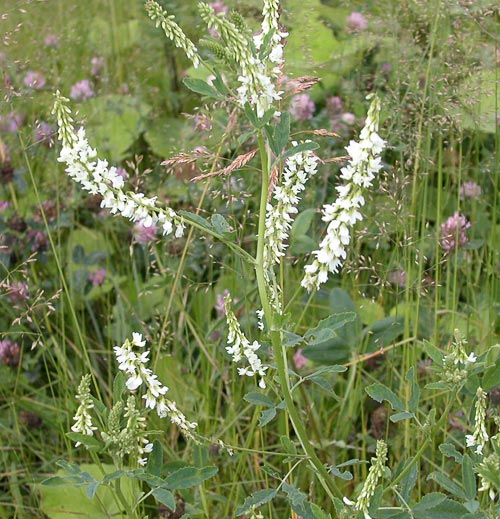Relatives
Melilotus albus Medic. - White sweet clover.
Taxonomic position.
Family Leguminosae Endl., genus Melilotus Mill.Synonyms.
White melilot, Bokhara clover.Biology and morphology.
Erect or ascending biennial or annual, up to 1.5 m tall, deeply tap-rooted, with trifoliate leaves. Leaflets obovate, dentate in upper third and with terminal leaflet on petiole longer than lateral leaflets. Single, well-branched stem during the first year of growth, but, in following year, several stems originate from crown buds. The succulent stems become fibrous with age. Inflorescences are 5-10 cm long, elongated, one-sided racemes of white flowers, 4-5 mm long, borne on long, axillary stalks. Seed pod has a reticulated, ridged coat, which turns black with ripening and contains a single, smooth, kidney-shaped seed, which is approximately 2 mm long and brownish yellow to brown in color. Indeterminate flowering. Blossoms in June-September; seeds ripen in July-October. Cross- pollinated mainly by honey bees. 2n =16, 24, 36.Distribution.
Occurs throughout the European part of the former USSR, the Crimea, the Caucasus, Western and Eastern Siberia, Kazakhstan and Middle Asia. Occurs as an invasive species in the Far East.Ecology.
Occurs in steppe meadows, on slopes, along rivers, and in ruderal places. Prefers open habitats. Plants is winter-hardy and productive, especially in fertile, well-drained clay and clay-loam soils. It also grows successfully in sandy loams and heavy, clay loams. It grows best in neutral or alkaline soils and is one of the best legumes to grow in highly alkaline soils. Its range extends from the lowlands up to the middle mountain level.Utilization and economic value.
Valuable forage plant. High nutritive value at vegetative stage of growth when grazed, at pre-flowering stage for silage, and at early-flowering stage for hay. The high coumarin content of sweet clover makes it less palatable to livestock than many other legumes. Scouring may also occur, especially when growth is young and succulent. Sweet clover is one of the best legumes for soil improvement. The widely-branched, deeply penetrating taproots open up the subsoil. The roots use nutrients not available to plants with shallow roots. Sweet clover is an excellent source of nectar and pollen for honey bees.Literature cited:
Brezhnev D.D., Korovina O.N. 1980. Wild relatives of the cultivated plants of flora of the USSR. L.: Kolos, 376 pp. (in Russian).Galushko A.I. 1980. Flora of the Northern Caucasus. A field guide. Vol. 2. Rostov-na-Donu, 350 pp. (in Russian).
Grossheim A.A. 1952. Flora of the Caucasus. Vol. 5. Genus Melilotus. M.-L.: Academy of Science of the USSR, p. 192-194. (in Russian).
Hulten E., Fries M. 1986. Atlas of Northern European Vascular Plants North of the Tropic of Cancer. Vol. 1-3. Koningstein, 1172 p.
Nikitin V.V., Geldihanov A.M. 1988. Field Guide of Plants of Turkmenia. L.: Nauka, 680 p.
Ovchinnikov P.N., ed. 1978. Flora of Tajikistan. Vol. 5. L.: Nauka, 678 pp. (in Russian).
Pavlov N.B., ed. 1961. Flora of Kazakhstan. Vol. 5. Alma-Ata: AN KazSSR, 515 pp. (in Russian).
Phyodorov A.A., ed. 1987. Flora of the European part of the USSR. Vol. 6. 254 pp. (in Russian).
Polozhiy A.B., Malyshev L.I., eds. 1994. Flora of Siberia. Vol. 9. Novosibirsk: Nauka, 280 pp. (in Russian).
Shishkin V.K., ed. 1945. Flora of the USSR. Genus Melilotus. Vol. 9. M.-L.: USSR, p. 176-189. (in Russian).
Suvorov V.V. 1950. Genus Melilotus. Flora of cultivated plants of the USSR. Vol. 8. M.-L.: Issue 1, p. 345-502. (in Russian).
Vvedenskiy A.I., ed. 1981. Plants of Asia Minor. A field guide. Vol. 6. Tashkent: Fan, 394 pp.(in Russian).


